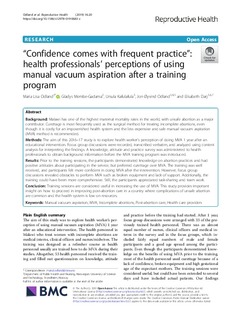| dc.contributor.author | Odland, Maria Lisa | |
| dc.contributor.author | Membe-Gadama, Gladys | |
| dc.contributor.author | Kafulafula, Ursula | |
| dc.contributor.author | Odland, Jon Øyvind | |
| dc.contributor.author | Darj, Elisabeth | |
| dc.date.accessioned | 2019-09-24T11:47:46Z | |
| dc.date.available | 2019-09-24T11:47:46Z | |
| dc.date.created | 2019-04-25T13:07:10Z | |
| dc.date.issued | 2019 | |
| dc.identifier.citation | Reproductive Health. 2019, 16 (20), 1-10. | nb_NO |
| dc.identifier.issn | 1742-4755 | |
| dc.identifier.uri | http://hdl.handle.net/11250/2618498 | |
| dc.description.abstract | Background
Malawi has one of the highest maternal mortality rates in the world, with unsafe abortion as a major contributor. Curettage is most frequently used as the surgical method for treating incomplete abortions, even though it is costly for an impoverished health system and the less expensive and safe manual vacuum aspiration (MVA) method is recommended.
Methods
The aim of this 2016–17 study is to explore health worker’s perception of doing MVA 1 year after an educational intervention. Focus group discussions were recorded, transcribed verbatim, and analyzed using content analysis for interpreting the findings. A knowledge, attitude and practice survey was administered to health professionals to obtain background information before the MVA training program was introduced.
Results
Prior to the training sessions, the participants demonstrated knowledge on abortion practices and had positive attitudes about participating in the service, but preferred curettage over MVA. The training was well received, and participants felt more confident in doing MVA after the intervention. However, focus group discussions revealed obstacles to perform MVA such as broken equipment and lack of support. Additionally, the training could have been more comprehensive. Still, the participants appreciated task-sharing and team work.
Conclusion
Training sessions are considered useful in increasing the use of MVA. This study provides important insight on how to proceed in improving post-abortion care in a country where complications of unsafe abortion are common and the health system is low on resources. | nb_NO |
| dc.language.iso | eng | nb_NO |
| dc.publisher | BioMed Central | nb_NO |
| dc.rights | Navngivelse 4.0 Internasjonal | * |
| dc.rights.uri | http://creativecommons.org/licenses/by/4.0/deed.no | * |
| dc.title | “Confidence comes with frequent practice”: health professionals’ perceptions of using manual vacuum aspiration after a training program | nb_NO |
| dc.type | Journal article | nb_NO |
| dc.type | Peer reviewed | nb_NO |
| dc.description.version | publishedVersion | nb_NO |
| dc.source.pagenumber | 1-10 | nb_NO |
| dc.source.volume | 16 | nb_NO |
| dc.source.journal | Reproductive Health | nb_NO |
| dc.source.issue | 20 | nb_NO |
| dc.identifier.doi | 10.1186/s12978-019-0683-z | |
| dc.identifier.cristin | 1693870 | |
| dc.description.localcode | Open Access This article is distributed under the terms of the Creative Commons Attribution 4.0 International License (http://creativecommons.org/licenses/by/4.0/), which permits unrestricted use, distribution, and reproduction in any medium, provided you give appropriate credit to the original author(s) and the source, provide a link to the Creative Commons license, and indicate if changes were made. | nb_NO |
| cristin.unitcode | 194,65,20,0 | |
| cristin.unitcode | 1920,13,0,0 | |
| cristin.unitname | Institutt for samfunnsmedisin og sykepleie | |
| cristin.unitname | Kvinneklinikken | |
| cristin.ispublished | true | |
| cristin.fulltext | original | |
| cristin.qualitycode | 1 | |

